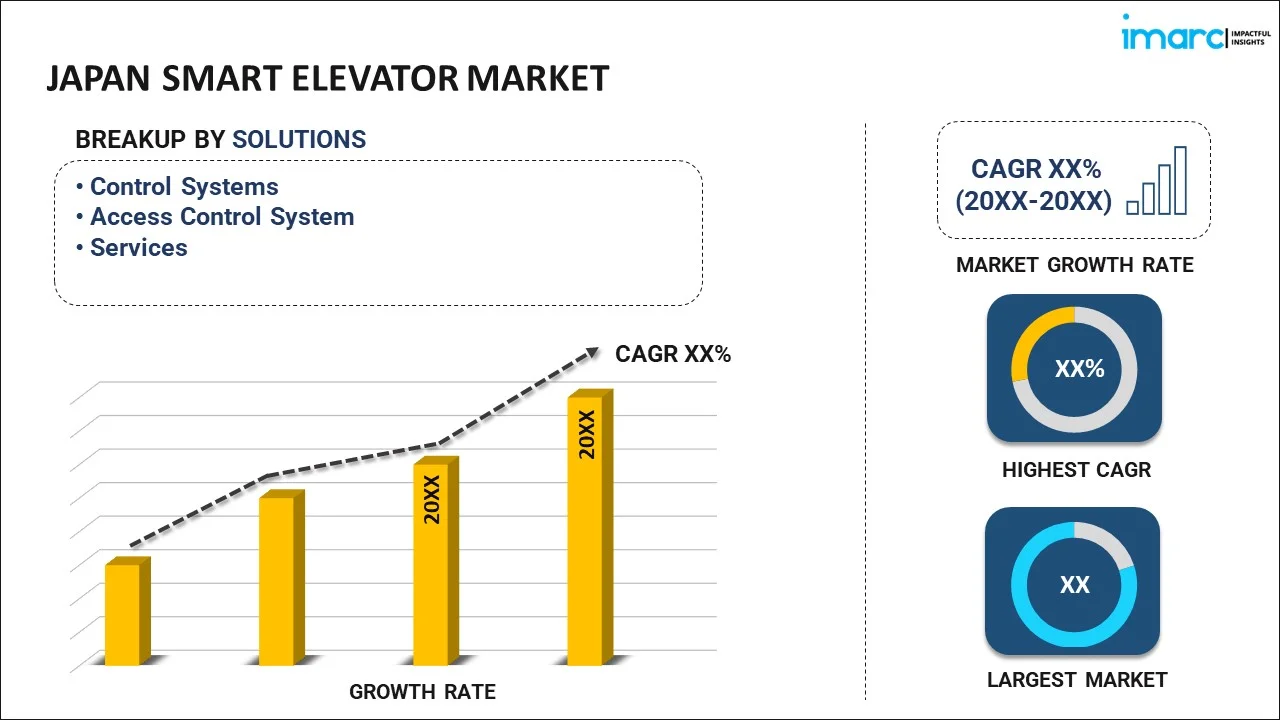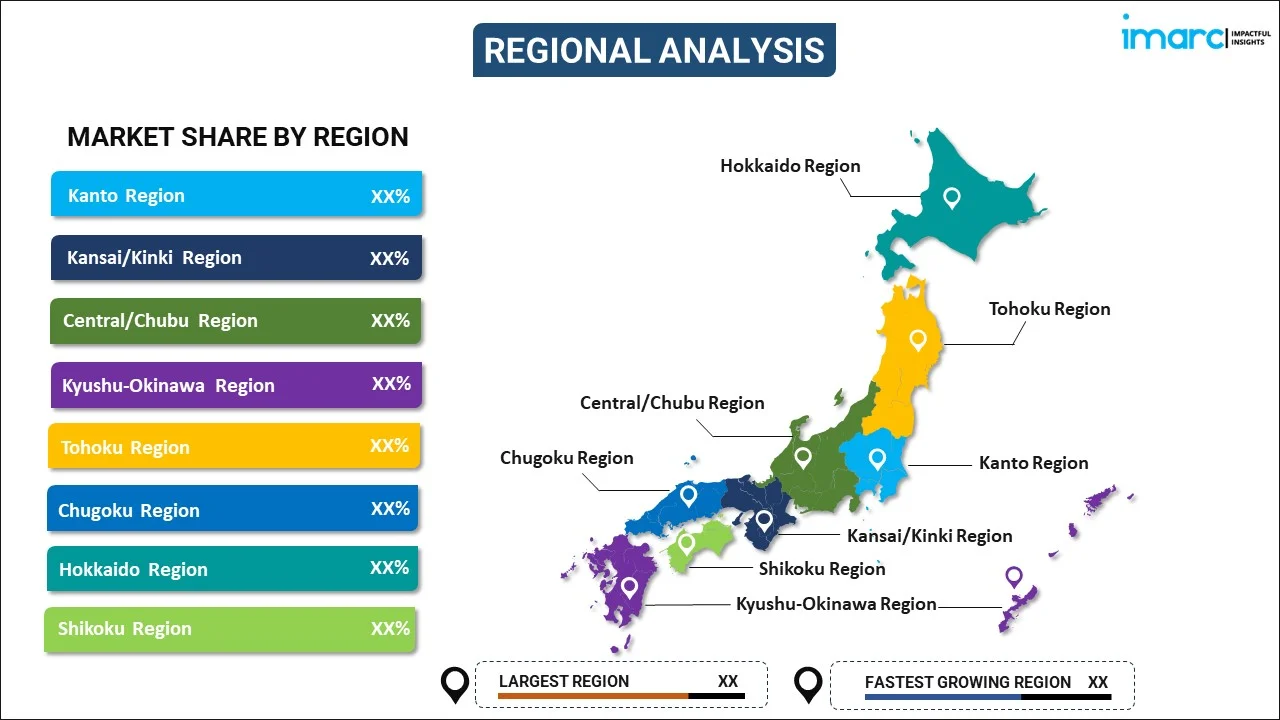
Japan Smart Elevator Market Report by Solution (Control Systems, Access Control System, Services), Application (Residential, Commercial, Industrial, Institutional, and Others), and Region 2025-2033
Market Overview:
Japan smart elevator market size is projected to exhibit a growth rate (CAGR) of 6.3% during 2025-2033. The widespread adoption of efficient mobility systems, owing to the rising high-rise buildings and the expanding working population, is primarily driving the market growth.
|
Report Attribute
|
Key Statistics
|
|---|---|
|
Base Year
|
2024 |
|
Forecast Years
|
2025-2033 |
|
Historical Years
|
2019-2024
|
| Market Growth Rate (2025-2033) | 6.3% |
Smart elevators represent cutting-edge vertical transportation systems designed for automated movement of passengers and cargo between different floors within a building. These advanced systems incorporate state-of-the-art digital security features, including destination dispatching, access control systems, biometric recognition, and touchscreen interfaces. They offer solutions to common elevator issues such as breakdowns, sluggish performance, and frequent maintenance needs. In doing so, they enhance the overall operational efficiency, reliability, aesthetics, and safety of elevators while simultaneously lowering energy consumption and reducing electromagnetic noise levels. Consequently, smart elevators are widely utilized across a spectrum of sectors, including residential, commercial, institutional, and industrial applications.
Japan Smart Elevator Market Trends:
In the context of the Japanese market, the growing emphasis on energy-efficient solutions driven by concerns regarding energy consumption is fostering a positive market outlook. Smart elevators have undergone enhancements in their controls, hardware, software, and components, such as AC motors, low-heat LED lighting solutions, and touch screens. These improvements not only conserve energy but also enhance overall efficiency. Furthermore, the widespread adoption of innovative permanent magnet synchronous (PMS) gearless traction machines, which consume less energy compared to traditional geared machines and offer a more compact and lightweight design, is contributing significantly to market growth. Moreover, the escalating demand for efficient mobility systems is another driving force, particularly in response to the increasing number of high-rise buildings and a growing workforce. This trend is propelling the expansion of the smart elevator market in Japan. Additionally, the integration of Internet of Things (IoT) and artificial intelligence (AI) technologies into smart elevators is gaining traction. These technologies enable remote diagnostics, emergency response capabilities, and enhanced safety features, which are becoming catalysts for market growth. Other contributing factors include the rising demand for modern amenities and the implementation of government initiatives aimed at promoting smart city projects in Japan. These factors collectively will bolster the market growth in the region over the forecasted period.
Japan Smart Elevator Market Segmentation:
IMARC Group provides an analysis of the key trends in each segment of the market, along with forecasts at the country level for 2025-2033. Our report has categorized the market based on solution and application.
Solution Insights:

- Control Systems
- Security Control System
- Elevator Control System
- Access Control System
- Maintenance Systems
- Communication Systems
- Services
- Support and Maintenance
- New Deployments
- Modernization
The report has provided a detailed breakup and analysis of the market based on the solution. This includes control systems (security control system and elevator control system), access control system (maintenance systems and communication systems), and services (support and maintenance, new deployments, and modernization).
Application Insights:
- Residential
- Commercial
- Industrial
- Institutional
- Others
A detailed breakup and analysis of the market based on the application have also been provided in the report. This includes residential, commercial, industrial, institutional, and others.
Regional Insights:

- Kanto Region
- Kansai/Kinki Region
- Central/ Chubu Region
- Kyushu-Okinawa Region
- Tohoku Region
- Chugoku Region
- Hokkaido Region
- Shikoku Region
The report has also provided a comprehensive analysis of all the major regional markets, which include Kanto Region, Kansai/Kinki Region, Central/ Chubu Region, Kyushu-Okinawa Region, Tohoku Region, Chugoku Region, Hokkaido Region, and Shikoku Region.
Competitive Landscape:
The market research report has also provided a comprehensive analysis of the competitive landscape. Competitive analysis such as market structure, key player positioning, top winning strategies, competitive dashboard, and company evaluation quadrant has been covered in the report. Also, detailed profiles of all major companies have been provided.
Japan Smart Elevator Market Report Coverage:
| Report Features | Details |
|---|---|
| Base Year of the Analysis | 2024 |
| Historical Period | 2019-2024 |
| Forecast Period | 2025-2033 |
| Units | Million USD |
| Scope of the Report | Exploration of Historical Trends and Market Outlook, Industry Catalysts and Challenges, Segment-Wise Historical and Future Market Assessment:
|
| Solutions Covered |
|
| Applications Covered | Residential, Commercial, Industrial, Institutional, Others |
| Regions Covered | Kanto Region, Kansai/Kinki Region, Central/ Chubu Region, Kyushu-Okinawa Region, Tohoku Region, Chugoku Region, Hokkaido Region, Shikoku Region |
| Customization Scope | 10% Free Customization |
| Post-Sale Analyst Support | 10-12 Weeks |
| Delivery Format | PDF and Excel through Email (We can also provide the editable version of the report in PPT/Word format on special request) |
Key Questions Answered in This Report:
- How has the Japan smart elevator market performed so far and how will it perform in the coming years?
- What has been the impact of COVID-19 on the Japan smart elevator market?
- What is the breakup of the Japan smart elevator market on the basis of solution?
- What is the breakup of the Japan smart elevator market on the basis of application?
- What are the various stages in the value chain of the Japan smart elevator market?
- What are the key driving factors and challenges in the Japan smart elevator?
- What is the structure of the Japan smart elevator market and who are the key players?
- What is the degree of competition in the Japan smart elevator market?
Key Benefits for Stakeholders:
- IMARC’s industry report offers a comprehensive quantitative analysis of various market segments, historical and current market trends, market forecasts, and dynamics of the Japan smart elevator market from 2019-2033.
- The research report provides the latest information on the market drivers, challenges, and opportunities in the Japan smart elevator market.
- Porter's five forces analysis assist stakeholders in assessing the impact of new entrants, competitive rivalry, supplier power, buyer power, and the threat of substitution. It helps stakeholders to analyze the level of competition within the Japan smart elevator industry and its attractiveness.
- Competitive landscape allows stakeholders to understand their competitive environment and provides an insight into the current positions of key players in the market.
Need more help?
- Speak to our experienced analysts for insights on the current market scenarios.
- Include additional segments and countries to customize the report as per your requirement.
- Gain an unparalleled competitive advantage in your domain by understanding how to utilize the report and positively impacting your operations and revenue.
- For further assistance, please connect with our analysts.
 Inquire Before Buying
Inquire Before Buying
 Speak to an Analyst
Speak to an Analyst
 Request Brochure
Request Brochure
 Request Customization
Request Customization




.webp)




.webp)












